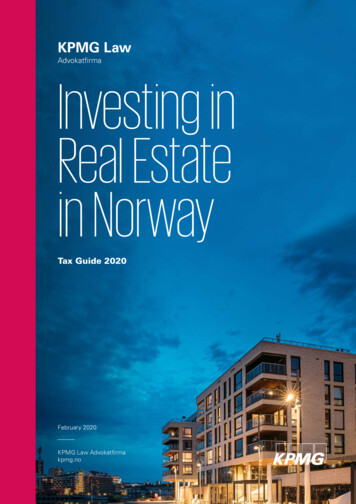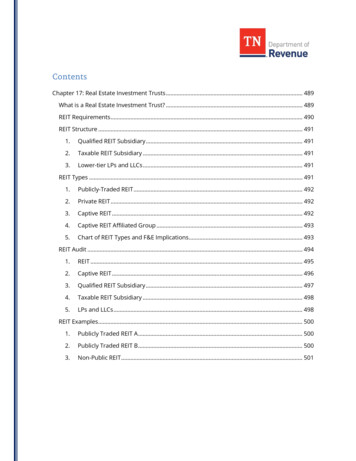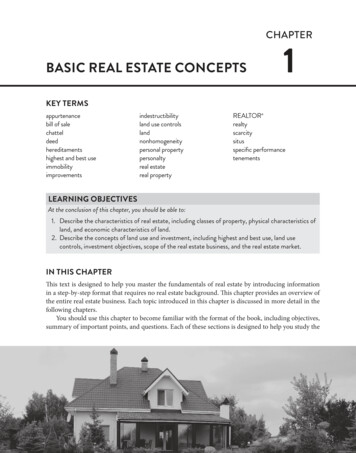
Transcription
KPMG LawAdvokatfirmaInvesting inReal Estatein NorwayTax Guide 2020February 2020KPMG Law Advokatfirmakpmg.no
2Investing in Real Estate in Norway1. General22. Purchase of real estate32.1. Introduction32.2. Real estate transfer tax / stamp duty32.3. VAT42.4. Valuation of tax positions52.5. Financing62.6. Financial assistance regulations62.7. Cost related to the purchase of real estate62.8. VAT related to the purchase of real estate72.9. Anti-avoidance72.10. Other73. Sale of real estate83.1. Sale of real estate83.2. VAT – Adjustment obligations83.3. Sale of shares or participation83.4. Deductions of costs related to thesale of real estate93.5. Distribution of proceeds from a sale94. Taxation of real estate1 GeneralInvesting in real estate in Norwaymay essentially be carried outin three different ways; a directinvestment in the real estate, apurchase of a tax-transparent entityor a limited company.The tax treatment and transaction costswill differ, and an investor should thereforealways consider what would provide themost efficient structure for their investment.Generally, most real estate transactionsare carried out by purchasing either atransparent entity or a limited company inorder to avoid stamp duty (payable by thepurchaser) and capital gains tax (seller).104.1. Corporate income tax104.2. Value added tax154.3. Local municipality tax15 2020 KPMG Law Advokatfirma AS, a Norwegian limited liability company and a member firm of the KPMG network of independentmember firms affiliated with KPMG International Cooperative (“KPMG International”), a Swiss entity. All rights reserved.
Tax Guide 20202 Purchase of real estate2.1. IntroductionAs mentioned above, most real estate transactions are carried out bypurchasing either a transparent entity or a limited company. For real estatethat will be developed and sold as residential property this is, however, notalways the case.The rationale for selling real estate either througha transparent entity or a limited company is mainlyto avoid a 22% corporate income tax charge(please see below in section 3.3. for the sale ofparticipations in a transparent entity) on the realisedgains and a 2.5% stamp duty on the fair marketvalue (FMV) of the real estate for the purchaser.Furthermore, land cannot be depreciated, whichmeans that the purchaser will normally not benefitfrom the higher tax book value on the land if anasset deal is carriedout. In addition,the purchaser willassume all liabilitieswhen acquiring thecompany, which isbeneficial for theseller.If an asset deal is carried out, a purchase priceallocation (PPA) must be made, as the purchaseprice must be allocated between the differentassets acquired (mainly between the building,technical installations, and land).2.2. Real estate transfer tax / stamp dutyThe transfer of immovable property and rightsin immovable property is subject to stamp duty.The purchaser is liable to pay the stamp duty. Therate is 2.5% of the transferprice of the property (fairmarket value). Except forstamp duty, no specialtaxes or charges are leviedon a transfer of immovableproperty.Furthermore, land cannot bedepreciated, which means thatthe purchaser will normallynot benefit from the higher taxbook value on the land if anasset deal is carried out.In the event thatthe seller wouldincur a loss, itmay be beneficialto sell the realestate as an assetdeal. However, it isimportant to consider the stamp duty payable (onthe transaction price / FMV), as this could exceedthe benefit of an asset sale. In addition, the latenttax benefit in the unrealised loss on the real estatecould affect the purchase price.A transfer betweencompanies that is or couldhave qualified as a taxexempt transfer, mainlyas tax-exempt mergers ordemergers, is howeverexempt from stampduty. It is not required that the transfer is in facttax-exempt, provided the transfer could havequalified as such. In certain scenarios where ataxable transaction is considered beneficial, itmay consequently nevertheless be possible tostructure the deal in such a way as to mitigatestamp-duty on the transfer. 2020 KPMG Law Advokatfirma AS, a Norwegian limited liability company and a member firm of the KPMG network of independentmember firms affiliated with KPMG International Cooperative (“KPMG International”), a Swiss entity. All rights reserved.3
4Investing in Real Estate in Norway2.3. VATSale of real estate is in general exempt from VAT.However, upon purchasing commercial real estate, thebuyer will in most cases find that there are VAT-liabilitiesattached to the property in the form of adjustmentobligations (see 3.1 for a closer description). From thebuyer’s point of view, it is vital to clarify if there are suchliabilities, as well as the nature and size of the liabilities.These liabilities may come in two forms. Adjustmentduty will require the buyer to repay VAT to the authorities,should the VAT liable use of the property decline.Adjustment rights will allow the buyer to increase hisdeductions (possibly triggering a refund) should the VATliable use of the property increase.In total, this means that the intended use of the propertymay trigger adjustments, both in a positive and a negativeway. A seller will in most cases expect the buyer topurchase the property with all adjustment obligationsintact, and will set the price in accordance with thisexpectation. As adjustments may carry a fiscal risk orbenefit, it is recommended that these obligations aremapped in advance, to ensure a proper valuation.If the purchase is made through theacquisition of shares, the sale will notbe subject to VAT. Such purchasesare exempt from VAT. In general thiswill mean that any VAT incurred duringthe process (legal assistance, duediligence etc.) will not be deductible.If a property is purchased outright, the transfer ofadjustment obligations is a matter of negotiation. On theother hand, if a property changes ownership through atransfer/sale of shares, the obligations will automaticallybe transferred.If the purchase is made through the acquisition of shares,the sale will not be subject to VAT. Such purchases areexempt from VAT. In general this will mean that anyVAT incurred during the process (legal assistance, duediligence etc.) will not be deductible. If the purchase iscarried out by using an acquisition vehicle, it might bepossible to argue that transaction costs are deductible inaccordance with the level of VAT liable activity if certainrequirements are met. Due to recent case law, it is vitalthat the VAT-classification of the services utilized duringthe process is assessed and classified in advance.In summary, there are several potential VAT issueswhen purchasing commercial real estate. The nature ofthe issues will depend on the method of purchase aswell as the state of the property, and should be clarifiedthoroughly before a purchase is made. 2020 KPMG Law Advokatfirma AS, a Norwegian limited liability company and a member firm of the KPMG network of independentmember firms affiliated with KPMG International Cooperative (“KPMG International”), a Swiss entity. All rights reserved.
Tax Guide 20202.4. Valuation of tax positions2.4.1. Tax book value on assetsIf a purchase is carried out as a purchase of either atransparent entity or a limited company, the tax positionsrelated to the real estate will be acquired and carriedforward, and the purchaser will therefore assume thelatent tax position and the historical (lower) basis for taxdepreciations.It is not possible to achieve a “step-up” on the cost-base ofthe purchased assets when acquired indirectly through theacquisition of a property-holding company, thus the directbenefit for the purchaser is merely that no stamp duty willbe levied. For the seller, the benefit is that no tax is leviedon the latent tax on the assets.Due to the fact that most realestate transactions are carried outas a sale of a transparent entityor a limited company, there is nopurchase price discount linked tothe latent tax on the purchasedassets (as it is assumed that thelatent tax will never be realised).The purchase price will howeverin most cases reflect a discountrelated to the lack of “step-up” onthe tax cost and, consequently,foregone tax depreciations.it is common that the seller asks that bids specify therate of the tax discount and the assumed allocation toland (which is unaffected by the tax discount). A sellermay also state a specific allocation to land, which meansthat a bidder may only specify the applied rate of taxdiscount. The decisive factor for the seller is generally thenet purchase price offered, and the tax discount may be awholly commercial consideration.Barring such considerations, buildings which aredepreciated at a rate of 2% annually (commercial property)are generally subject to a tax discount rate between 710%. For buildings which are depreciated at a rate of 4%annually (industrial property and similar) the discount ratemay be up to 13-14%. Residential property is generally notsubject to tax depreciations andtherefore generally not subject to atax discount.There is no tax depreciationon land, and the discountis therefore only linked tothe difference between thevalue of the building andthe tax book value.There is no tax depreciation on land, and the discount istherefore only linked to the difference between the valueof the building and the tax book value, which is depreciablefor tax purposes (mainly buildings and technicalinstallations).In principle, the discount should reflect the net presentvalue of tax depreciations foregone / lost in the acquisitiondue to it not being carried out as an asset-deal (withcorresponding step-up on tax depreciable assets).In practise, the discount is subject to negations andcommercial considerations and will often not reflectdetailed valuation-considerations. In market-transactions,5As the general corporate tax ratehas been reduced in recent years,from a nominal rate of 28% to22% per 2020, the market practicefor tax discounts may be subjectto change.2.4.2. Other tax positionsIn addition, there are other taxpositions to consider if a limitedcompany is being purchased.Typically, the tax positions relateto tax losses carried forward and gains and lossesaccounts (see section 3.1).Similar to the above, the valuation and purchase priceimplication of such positions are subject to negotiationsand commercial considerations. For both positions,the net present value of the tax asset / liability will bea decisive fact, taking into consideration factors suchas how soon a tax loss carry forward may be utilizedand when a deferred tax liability will become payable.In practice, however, the tax positions are often valuedcomparably with the overall tax discount rate applied inthe transaction. 2020 KPMG Law Advokatfirma AS, a Norwegian limited liability company and a member firm of the KPMG network of independentmember firms affiliated with KPMG International Cooperative (“KPMG International”), a Swiss entity. All rights reserved.
6Investing in Real Estate in Norway2.5. Financing2.7. Cost related to the purchase of real estateWhen purchasing real estate it is typical that theacquisition is carried out through a mix of equityand debt. In order to obtain relief for interestexpenses, foreign investors often use an existingholding company or establish an acquisitioncompany in Norway to efficiently leverage theacquisition structure. It may also be possible toobtain an interest deduction in Norway if acquiringreal estate directly by a foreign taxpayer.As a main rule, costs incurred in order to obtain, maintainor secure taxable income are deductible. Acquisitioncosts are generally required to be capitalised on theacquired asset. If the acquisition is carried out as adirect acquisition of a property (“asset deal”), the costis generally deducted through depreciation of the capitalasset. If the acquisition relates to an acquisition of sharesin a property holding company (“share deal”), then theacquisition cost in generally capitalized on the shares andno tax deduction is in effect obtained.As a starting point, all interest paid is deductiblefor the calculation of the taxable income ofthe taxpayer. A general arm’s length principleapplies both with respect to the level of interestcharged on related-party debt and the debt/equityratio (“thincap”). In addition, an EBITDA-basedearnings stripping rule applies, also with respectto debt on unrelated-party debt (see section 4.1.3.below). Debt-levels, allocation of debt, interestrates applied and the mix between external andinternal financing must be carefully structured.There is currently no interest withholding tax inNorway but a public discussion paper to this effectis expected in 2020 (although already subjectto a number of delays). It may therefore be thatan interest withholding tax is introduced in thefuture. Currently, most Norwegian tax treatiesoffer a full exemption from interest withholdingtax, subject to a beneficial ownership test.2.6. Financial assistance regulationsAs a starting point, a target company mayonly provide collateral, loans or other fundingor security to an acquiring entity (financialassistance) within the headroom of itsdistributable equity. A practical exceptionapplies, however, if the target company, afterthe acquisition, forms part of the same group asthe acquiring company (provided the acquiringentity is resident within the EU / EEA). Financialassistance can in such cases be grantedregardless of the distributable equity of the target,but a number of procedural requirements must bemet, hereunder the board of directors must affirmthat the financial assistance is in the interest ofthe target company and that the company willmaintain a reasonable equity and liquidity afterhaving granted the financial assistance.Whether a Norwegian taxpayer can claim tax deductionsfor costs paid to an affiliated party in an acquisitionprocess depends on whether such costs can beallocated to the Norwegian taxpayer. Broadly, thedeductibility is contingent on the fulfilment of a “benefittest”, whereby it must be demonstrated that the costshave been incurred as remuneration for services that willbenefit the taxpayer, as opposed to the shareholders.If the costs can be charged to the Norwegian company,it must be assessed whether the costs are deductibleimmediately, or whether they must be capitalised (addedto the tax book value of the assets of the company). Ifcosts must be capitalised, they will become deductibleat a subsequent realisation of the acquired object(by reducing a future gain/increasing a future loss) orthrough depreciation. An increased tax book value wouldnormally be deductible by way of depreciation. Costsincurred in connection with the acquisition of sharesmust as a general rule be capitalised on the shares. Theyare in effect non-deductible, as gains on shares are taxexempt and losses are non-deductible.When assessing whether to deduct or capitalise anexpense, the deciding factor will be the purpose forwhich the expense is incurred. For instance wherea service is acquired with an objective to utilise ittowards the future operation of the target company,the associated costs will normally be immediatelydeductible (e.g. cash flow and tax structuring). If theexpenses are related to the acquisition as such (i.e.brokerage fees, legal advice in relation to contracts), oran up-to-date assessment of the company (historical duediligence), such expenses must normally be capitalisedon the acquired shares. An exception to this principle isfinancing fees, which are unconditionally deductible.For broken deals, costs must be treated in the same wayas for completed transactions, which means that costswhich would have been capitalised on the shares if theywere acquired, are non-deductible. 2020 KPMG Law Advokatfirma AS, a Norwegian limited liability company and a member firm ofthe KPMG network of independent member firms affiliated with KPMG International Cooperative(“KPMG International”), a Swiss entity. All rights reserved.
Tax Guide 202072.8. VAT related to the purchase of real estateCosts incurred inconnection with theacquisition of sharesmust as a general rule becapitalised on the shares.For VAT purposes, the costs must be broken down andclassified as VAT recoverable, VAT non-recoverable orVAT exempt. As a main rule, input VAT charged on costsrelated to a company’s VAT liable activities (i.e. businessoperations subject to VAT) may be recovered, whileinput VAT charged on other costs may not be recovered.Certain services, e.g. financing, are VAT exempt,meaning that no VAT should be invoiced (and no VATshall be calculated according to the reverse chargemechanism). Broadly, costs must be split betweenthose related to the financing operation, and thoserelated to the acquisition itself. Only the latter maybe deductible. In all instances it will be necessary toclosely review the costs to ensure correct classification.The purchase of shares is deemed to be of a financialnature end outside the scope of the VAT-act. As such,VAT incurred on acquisition costs is non-recoverable,regardless of the potential VAT-liable businessundertaken in the target company itself.The purchase of real estate is likewise outside thescope of the VAT-act, and as with a share deal VAT onacquisition, costs are non-recoverable.However, if the acquisition takes the form of an assetpurchase, and the underlying asset can be qualified asan ongoing activity (typically in the form of the buildingand a set of active rental agreement, this may qualifyas TOGC (transfer of going company)). TOGC is subjectto VAT, but zero rated. This may however allow for thededuction of VAT on the acquisition costs.2.9. Anti-avoidanceNorway has a general and a specific anti-avoidanceprovision which may apply if the transaction or aseries of transactions is deemed mainly motivatedby obtaining a tax benefit / advantage. In real estatetransaction, the most practical issue would beacquisition of companies with significant tax loss carryforwards or other tax attributes. Provided there is agenuine business rationale behind the transaction, therisk of being in scope of the anti-avoidance provisionsshould be limited.2.10. OtherThere are specific regulations concerning acquisitionsof land in Norway, mainly these are properties for theexploitation of natural resources, such as farmland,hydropower and forests. 2020 KPMG Law Advokatfirma AS, a Norwegian limited liability company and a memberfirm of the KPMG network of independent member firms affiliated with KPMG InternationalCooperative (“KPMG International”), a Swiss entity. All rights reserved.
88Investing in Real Estate in Norway3 Sale ofreal estate3.1. Sale of real estateIn general, capital gains/losses onthe sale of real estate (asset deal)are taxable/deductible regardless ofthe seller’s tax residence.The gain is taxed at 22%. Normally, gainsfrom a sale of real estate can be transferredto a gain and loss account, where at least20% of a positive balance on the accountmust be recognized as income annually ona declining balance basis. Gains relatingto technical installations are recognisedunder the same method, but on a separateaccount.Due to the exemption method, the sellerwill normally prefer to sell his shares orparticipation to avoid tax on the latent gainon the real estate.3.2. VAT – Adjustment obligationsFor VAT, the key issue is adjustment obligations.Upgrades exceeding a set threshold are subject toadjustments, meaning that the level of deductionis dependent on use within a VAT liable line ofbusiness for the next ten years.A sale of the property will trigger an obligation topartially reverse the deduction. The percentage ofthe reversal will depend on the number of yearsleft of the ten years period. This reversal may,however, be avoided, provided that the buyeraccepts responsibility for the remaining period.From a seller’s point of view, it is preferable totransfer the obligation to the buyer in order toavoid having to repay VAT. If the buyer is unwillingto accept the transfer, this should be reflected inthe price.It should, however, be noted that for the buyer,the adjustment obligation represents a potentialrisk, and the buyer will likely keep this risk in mindwhen making an offer.When selling real estate, it is particularlyimportant to note that for the sale of developmentproperties where no physical work has beenperformed at the site, it will not be possible totransfer adjustment obligations for servicesrelated to non-physical development work. Theconsequence could be that any input VAT incurredwill be a final cost without the possibility ofreclaiming the input VAT.Note also that it has been indicated by the VATAdministration that when transferring projectsunder construction and empty buildings, the selleris obliged to reverse all VAT deducted to date. ThisVAT may be transferred as a latent deduction,and claimed by the buyer at a later date, once thepremises are occupied.3.3. Sale of shares or participationCapital gains on shares in a Norwegian companyor participation in a transparent Norwegian entityowned by a Norwegian limited liability companyor a Norwegian transparent entity are tax exemptunder the Norwegian exemption method, andlosses are non-deductible (see section 4.1.6.below). For foreign investments the gains may becovered by the exemption method. 2020 KPMG Law Advokatfirma AS, a Norwegian limited liability company and a member firm of the KPMG network of independentmember firms affiliated with KPMG International Cooperative (“KPMG International”), a Swiss entity. All rights reserved.
Tax Guide 2020The sale of shares in a Norwegian companywill not result in any tax charges in Norway,unless the foreign entity is considered to havepermanent establishment in Norway. TheNorwegian Tax Act does not have legal basisfor imposing tax on a non-resident’s gain onshares.If a foreign investor sells a participation ina transparent Norwegian entity, the taxtreatment is somewhat unclear. According tothe Norwegian Ministry of Finance the foreigninvestor will be considered to have realisedhis share of the underlying assets, and shouldthus be taxed at 22% on any realised gains,unless the income is tax exempt. Since suchgain would be tax exempt for a Norwegianinvestor, the tax treatment may be in breachwith Norway’s obligations under the EEAagreement.The seller is not required to calculate VAT onthe fee, as sales of sharers or participation arenot liable for VAT. Note that the seller cannotexpect to gain deductions for any VAT incurredas part of the sales process.3.4. Deductions of costs related to the saleof real estateCosts directly related to a sale of real estate,such as broker commission, advertisementetc. are tax deductible, if the gain is taxable.If the real estate is sold as a sale of shares orparticipation, the costs will be linked to the saleof the shares or participation, and be treatedas non-deductible. For broken deals, the costsmust be treated similarly, which means thatmost costs are non-deductible.For VAT purposes, deductibility of input VATon costs incurred during the sale is unclearunder current law. A recent decision from thelower court indicates that VAT on sales costs isnon-recoverable. Deductions may be allowedif the sale can be viewed as winding down aVAT liable business, for instance renting outproperty under a voluntary registration. Thisgenerally means that the real estate should besold as a running business, with tenants intact. 2020 KPMG Law Advokatfirma AS, a Norwegian limited liabilitycompany and a member firm of the KPMG network of independentmember firms affiliated with KPMG International Cooperative (“KPMGInternational”), a Swiss entity. All rights reserved.3.5. Distribution of proceeds from a sale3.5.1. Permanent establishmentIf the real estate is owned directly by a foreigninvestor (i.e. in effect through a taxable branch/property in Norway), the proceeds can bedistributed without any tax being levied inNorway.3.5.2. Limited companyThere are different ways for a limited companyto distribute the proceeds from the sale ofreal estate. The proceeds could be distributedthrough dividends, a repayment of paid-incapital, repayment of loans or liquidation.The taxation for a Norwegian investor woulddepend on the investor. For foreign investors,the tax treatment depends on the repaymentmethod. In Norway, there is currently onlywithholding tax on dividends, at a domesticrate of 25%. The rate may be reduced forcorporate shareholders within the EEA orunder an applicable tax treaty (see section4.1.7. below). Repayment of paid-in capital isnot taxable. If a company is liquidated, theliquidation proceeds will be considered ascapital gains on shares, and not a distributionof dividends for Norwegian tax purposes, andno withholding tax will be levied.3.5.3. Transparent entityDistributions from transparent entities aretax exempt for Norwegian investors, exceptfor a 3% claw back. There is no tax charge ondistributions to foreign investors.9
10Investing in Real Estate in Norway4 Taxation of real estate4.1. Corporate income tax4.1.1. GeneralThe tax rate on corporate income is currently 22%.Taxable income includes capital gains.As a main rule, costs are deductiblefor tax purposes provided they are forexpenses incurred in order to acquire,maintain or secure taxable income.Costs for maintaining/upholding thesame standard of the property are ingeneral deductible. If the costs arerelated to upgrading the propertystandard the costs must be capitalised.The main rule for the timing of incomeand costs is the realisation principle.For income this implies that the incomemust be recognized for tax purposes inthe same year as the taxpayer obtains anunconditional right to the remuneration.For costs, the realisation principleimplies that the costs are deductible inthe income year in which the taxpayerincurs an unconditional obligation topay the remuneration. The time ofpayment formally agreed upon is of noconsequence.4.1.2. Tax deprecationAll types of property and technicalinstallations are subject to the decliningbalance method of depreciation.The depreciation rates for real estatedepend on the type of property. Officebuildings and other commercial propertymay be depreciated at 2% per annum. Ifthe expected economic life of a buildingis less than 20 years, a 10% rate may beapplied. Other properties are depreciatedat a 4% rate. Technical installations maybe depreciated at 10% per annum. Landmay not be depreciated for tax purposes.Maintenance costs that are considerednecessary to uphold taxable incomeare tax deductible in the year of accrual.Costs for improvements to the buildingmust be capitalised and depreciatedtogether with the cost of the building.4.1.3. Transfer pricing and thincapitalisationInterest costs are as a main rule fullydeductible on an accruals basis, andthere is as a starting point no differencebetween debt from shareholders/intragroup and debt from unrelated parties.The arm’s length principle applies torelated party loans, and the tax authoritiesmay make a reassessment based on thincapitalisation or an adjustment of theinterest rate. 2020 KPMG Law Advokatfirma AS, a Norwegian limited liability company and a member firm of the KPMG network of independentmember firms affiliated with KPMG International Cooperative (“KPMG International”), a Swiss entity. All rights reserved.
Tax Guide 20204.1.3. Transfer pricing and thin capitalisationInterest costs are as a main rule fully deductible onan accruals basis, and there is as a starting point nodifference between debt from shareholders/intragroup and debt from unrelated parties.The arm’s length principle applies to relatedparty loans, and the tax authorities may make areassessment based on thin capitalisation or anadjustment of the interest rate.4.1.4. Interest limitation rules / earnings strippingEffective for all financial years ending on or after 1January 2019, deductibility of net interest expenses(regard of the status of the payee, i.e. both relatedand non-related party debt) is limited to 25% of theborrower’s “tax EBITDA“, if the borrower is part of aconsolidated group (or could have been under IFRSprinciples).The main rule for thetiming of incomeand costs is therealisation principle.Broadly, the tax EBITDA can be represented as:Taxable income /- Group contributions received (/surrendered)- Use of tax losses carried forward /- Net interest expenses /- Tax depreciations “Tax EBITDA”A de minimis threshold applies at Norwegian grouplevel: If the total interest cost is less than NOK 25million, the rules do not apply.Equity escape provisionsTaxpayers may claim relief for all net interestexpenses if they qualify for the “equity escapeprovisions”. Broadly, the provisions seek toestablish whether the borrower (or the Norwegiansubgroup as a whole) is over-indebted relative to theworldwide consolidated group.The taxpayer can claim relief for interest in excessof the EBITDA threshold provided the ratio of thetaxpayer’s equity to total assets is equal to or higherthan the corresponding ratio of the worldwideconsolidated group (see below for the definition ofthe group). 2020 KPMG Law Advokatfirma AS, a Norwegian limited liability company and amember firm of the KPMG network of independent member firms affiliated with KPMGInternational Cooperative (“KPMG International”), a Swiss entity. All rights reserved.11
12Investing in Real Estate in NorwayFor the purposes of the comparison, a number ofadjustments to the borrower’s financial statements arerequired:–Goodwill (or badwill) in the consolidated financialstatements attributable to the borrower must beadded to (or subtracted from) total assets and equity.–The assets and liabilities of the borrower mustbe revalued in accordance with the consolidatedfinancial statements, and added to (subtracted from)total assets and equity / liabilities.–Deferred tax liabilities / assets relating to the revaluedassets / liabilitie
sale of real estate 2.9. Anti-avoidance 7 2.6. Financial assistance regulations 6 3.5. Distribution of proceeds from a sale 9 2.10. Other 7 2.7. Cost related to the purchase of real estate 6 4. Taxation of real estate 10 3. Sale of real estate 8 1 General Inv










